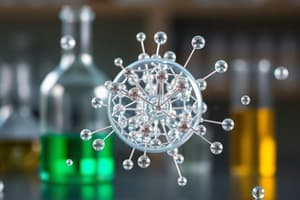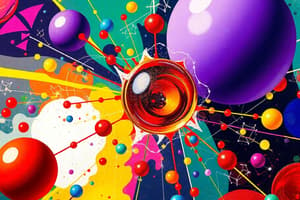Podcast
Questions and Answers
Match the following terms with their definitions:
Match the following terms with their definitions:
Solubility = Ability of a substance to dissolve in a solvent Concentration = Measure of the amount of solute present in a solvent Homogeneous mixture = Uniformly distributed mixture like a well-blended smoothie Heterogeneous mixture = Mixture with components not uniformly distributed like a bowl of trail mix
Match the following separation methods with their descriptions:
Match the following separation methods with their descriptions:
Sedimentation = Settling of heavier particles at the bottom of a mixture Filtration = Passing a mixture through a filter to separate solid particles from liquid Distillation = Separating components based on differences in boiling points Decantation = Pouring off liquid from settled solid particles
Match the following types of substances with their characteristics:
Match the following types of substances with their characteristics:
Pure substances = Can be thought of as exclusive parties with only one type of particle Mixtures = Open parties with various types of particles present Elements = Pure substances made up of a single type of atom Compounds = Pure substances made up of multiple types of atoms bonded together
Match the following terms with their analogies from party scenarios:
Match the following terms with their analogies from party scenarios:
Match the following statements with the correct explanation:
Match the following statements with the correct explanation:
Match the following with their descriptions:
Match the following with their descriptions:
Match the following with their examples:
Match the following with their examples:
Match the following with their definitions:
Match the following with their definitions:
Match the following with their analogies from party scenarios:
Match the following with their analogies from party scenarios:
Flashcards are hidden until you start studying
Study Notes
- Everything around us is made up of particles, even we ourselves
- Particles can form pure substances, where all particles are identical, or mixtures, where different types of particles are present
- Pure substances can be thought of as exclusive parties with only one type of particle, while mixtures are open parties with various types of particles
- Particle theory helps distinguish between pure substances and mixtures, as in pure substances, particles are identical, while in mixtures, they retain their individual properties
- Homogeneous mixtures are uniformly distributed throughout the mixture, like a well-blended smoothie, where the components cannot be distinguished
- Heterogeneous mixtures, like a bowl of trail mix, have components that are not uniformly distributed and can be easily separated
- Solubility is the ability of a substance to dissolve in a solvent; water is a universal solvent due to its polarity
- Saturated solution is a party that's at full capacity, while an unsaturated solution can still accommodate more guests (solute)
- Concentration is a measure of the amount of solute present in a solvent
- Separation methods include sedimentation, decantation, filtration, evaporation, distillation, and centrifugation
- Elements are pure substances made up of a single type of atom, while compounds are pure substances made up of multiple types of atoms bonded together
- Elements and compounds have unique properties and can be interchangeable
- Particle theory helps explain the behavior of matter around us.
Studying That Suits You
Use AI to generate personalized quizzes and flashcards to suit your learning preferences.




